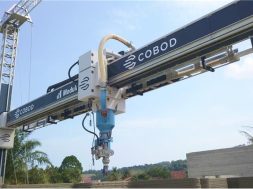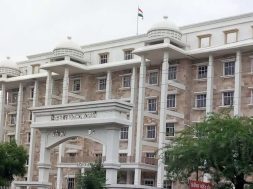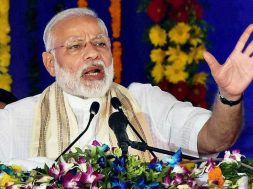Ports and shipping industry making waves
With a vast stretch of coastline, India opens up bright prospects for the shipping and ports sector.
More than 90 per cent of India’s international trade volumes are carried through the sea route, making ports one of the most critical components of India’s freight value chain. In order to ensure the sector’s all round robust and integrated growth, the government is also planning to evolve a model of port-based development by facilitating modernisation of existing ports as well as development of world-class ports.
The focus With a vast stretch of coastline measuring 7,517 km, India opens up bright prospects for the shipping and ports sector. “India’s 13 major ports and 187 minor and intermediate ports together serve 90 per cent of the nation’s maritime trade reflecting the heightened importance of this sector in India’s international trade,” says Vijay Kalantri, Chairman and Managing Director, Dighi Port Ltd. “The government has taken many measures to improve the efficiency of operations through mechanisation, deepening of draft and speedy evacuation. Two new major ports are being set up in Durgarajapatnam and Sagar in Andhra Pradesh and West Bengal respectively under PPP mode in addition to the existing 13 ports.”
Ports and shipping have been constantly playing a vital role ever since civilisation began trade and commerce across oceans, and its future is poised to grow as the economy has picked up pace. “The Foreign Trade Policy for 2015-20 targets to double exports to $900 billion by the turn of this decade,” explains Anil Yendluri, Director and CEO, Krishnapatnam Port Company Ltd. “The growing external trade will only make our ports and shipping become busier and should also aim to become better. Also, the government envisages that our ports transform into world-class facilities suited to meet the requirements of the future economy of India.”
With India’s renewed focus on positioning itself as the global trade hub, ports and the shipping industry will play a very critical role to support our economies growth in coming years. With coastal shipping gaining preference for servicing over 7,000 km of India’s coastline as an alternative for road and rail, as a medium of transportation, the shipping industry is poised for a major growth in coming years for the economy. According to Adarsh Hegde, Executive Director, Allcargo Logistics, “With newer ports being operational both private as well as public, India’s overall capacity is also increasing day by day and competition among ports for attracting domestic as well as international cargo has led to adaptation of efficiency in service delivery as well as global benchmarks, in the way our economy managed EXIM.” These are all positive variables which are laying foundation for a more vibrant and fast-paced economic growth driven by ports and the shipping industry.
India and handling large shipsIn shipping , the bigger the vessel, the lower the freight cost for exporters and importers. However, it seems Indian ports aren’t ready to welcome big ships yet. Cargo ships are getting bigger to handle larger volumes from Asia, particularly China, to Europe and the US. “The container ship CSCL Globe is a mammoth ship and at present over 100 mega ships with carrying capacity of over 15,000 boxes on board sail the oceans,” describes Mr Kalantri. “Indian ports are equipped to handle vessels such as CSCL Globe, which is 1,313-feet long, 192-feet wide and 100-feet deep (with capacity of 19,100 containers). The average ship size handled at Indian ports is of a capacity of around 5,000 boxes. This is enough for now but as volumes increase multi-fold in future, ports need to be ready.”
Size matters. Size helps in achieving economies of scale, time advantage and energy efficiency. According to Mr Yendluri, “Indian ports, no doubt, are bracing up their infrastructure and capacity to accommodate large vessels, be they cape-size bulkers or E-class container ships. New ports too are being developed at shores endowed with natural deep draft. Krishnapatnam Port has been in the forefront in handling bigger vessels efficiently and is already called the ‘home for capes.’”
It’s no secret that in today’s world of constant EXIM trade, markets and consumers devoid of boundaries, larger ships are very important not only for creating cost efficiency but also to reach more markets in lesser amount of time. “ Developed economies of Singapore, Dubai and also to a major extent China have already initiated infrastructure across their ports to support this development,” explains Mr Hegde. “India is realising the demand and has already initiated in a gradual way, structure changes both in terms of infrastructure and policy to receive larger sized ships into its ports. As our economy moves into faster gear this change will be more prominent and will eventually match global standards as well.”
Government policies to keep the momentum Infrastructure development is critical to efficient port operations and growth of the hinterland. In recent years, the government has laid great emphasis on strengthening port infrastructure to ensure smooth movement of cargo from the ports to their final destinations through the hinterland. Even infrastructure for both major and non-major ports has attracted significant investment in recent years, augmenting overall port capacity to 1.3 billion tonnes. “The government policies and reforms focused on economic growth will have a ripple effect on supporting sectors, and this will boost the morale of investors, both native and foreign,” adds Mr Yendluri. “Strengthening of trade and fiscal regime, therefore, peps up equity and accelerates infrastructure and capacity building. This applies even to projects earmarked in the Maritime Agenda 2020.”No doubt the government is doing something right — easing outdated policies pertaining to the ports sector and bringing in amendments like corporatisation, 100 per cent FDI through automatic route and tax holiday. “These will help ports create capacities and improve efficiency, revenue generation and overall competitiveness,” explaisn Mr Yendluri. “Service tax on construction and capacity addition at the ports should be waived. Long-term, low-cost funds should be made available for the port.”
According to Mr Hegde, “The momentum should be defined keeping in mind where we foresee our economy and EXIM trade moving in coming decades. Port capacity expansion is inevitable to support over 5 per cent GDP growth, but it should also be complemented with support infrastructure such as road and rail connectivity to these ports, making it more each for cargo to reach and exit our ports.”The government should make India competitive in terms of doing business overall and keep logistics costs to its minimum, which will eventually propel us to the next level as a global trade hub.
Challenges affecting overall growthGreenfield non-major ports planned by the state governments have been delayed on account of slow land acquisition, security and environment clearances.
“Greenfield port projects are usually in remote locations and considerable government support is required to create basic infrastructure for site access,” says Mr Kalantri. “The developers of port projects often need to address the supply of manpower and their housing and infrastructure for habitation. Some of the challenges faced in respect of existing ports include inadequate road networks within port area, inefficiency due to poor hinterland connectivity through rail, road, highways, coastal shipping and inland waterways, inadequate navigational aids, facilities and IT systems, insufficient dredging capacity and lack of technical expertise.”
Port projects have a long gestation period and so greenfield ports face the challenge of sustained private financing for a considerable period of time coupled with the risk of sunk investment and deferred cost recovery and revenue. As mentioned, large number of clearances and procedures are delaying the projects. We should relook at all the existing policies and procedures and simplify them.Along with challenges, there are opportunities too. “Every country or an economy, especially a democracy like India, goes through these delays in terms of implementation of key reforms,” says Mr Hegde. “In the zeal to grow, we also need to focus on environmental preservations, national security concerns and plans as well as development of each and every citizen of our country.” He believes that once this foundation is laid, our growth in the future will be more seamless and sure. Thus these challenges are a must to create a path of future growth. These delays are more of a deliberation and an exercise towards consensus, as to where we are heading as country.
Preferred mode of port developmentOver the last decade our country went through a rough time in all aspects of our growth, and PPP projects have been a feasible mode of development. However, given the capital-intensive nature of port projects and the risk of long construction and payback period, equity contributions were relatively slow during the global economic slowdown. According to Mr Yendluri, “The scenario could change for the better towards the penultimate period of the 12th Five-Year Plan. The government have to play a proactive role in the matter, ease the procedure and help attract cheaper and long-term foreign investments into this sector.”
Although the critical projects within our country, including the ones driven by the PPP model, witnessed considerable setback, the sentiment is drastically changing now. “With a decisive government at the centre, with more focus on driving proactive economic initiatives, transparent policy making, focus on manufacturing and more seamless taxation, the market opportunity will again get a new fillip,” expects Mr Hegde. “This will again drive the renewed interest of investors and thus rejig the PPP model.”
It is estimated that India needs in excess of over $500 billion over the next decade to build infrastructure, PPP model is still the best way forward for our economy. The opportunity for India is here to stay. It’s just a matter of time of witnessing the results.____________________________________
The growing external trade will only make our ports and shipping become busier and should also aim to become better.
Anil Yendluri, Director and CEO, Krishnapatnam Port Company Ltd._______________________________________
As our economy moves into faster gear this change will be more prominent and will eventually match global standards as well.
Adarsh Hegde, Executive Director, Allcargo Logistics_____________________________________________
The average ship size handled at Indian ports is of a capacity of around 5,000 boxes. This is enough for now but as volumes increase multi-fold in future, ports need to be ready.
Vijay Kalantri, Chairman and Managing Director, Dighi Port Ltd.___________________________________________
23
Cookie Consent
We use cookies to personalize your experience. By continuing to visit this website you agree to our Terms & Conditions, Privacy Policy and Cookie Policy.









